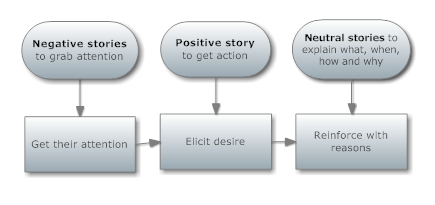 Your blog writing can improve. I’ve talked about this before: here’s a secret formula you can use to grab people’s attention, stimulate their desire, and trigger action. Ba-da-boom, instant sales and subscriptions!
Your blog writing can improve. I’ve talked about this before: here’s a secret formula you can use to grab people’s attention, stimulate their desire, and trigger action. Ba-da-boom, instant sales and subscriptions!
Don’t be silly, there are no easy formulas, of course not. But just follow along with me here. I’ve been reading several neuroscience and communications books that say the same things in different ways, and I think these persuasion tips can easily apply to better blog writing.
Take a look at this diagram I whipped up with SmartDraw:
Grabbing readers’ attention is the first step, of course. (By the way, this doesn’t only apply to blog writing, but to other content marketing pieces and in general for other things you write for the web.)
Attention is generally done more effectively by negative content. That’s because negative stories wake us up. They activate the more primitive centers of the brain, especially the centers for fight or flight.
Negative stories start us thinking. For example, a reader might jolt up in their chair and think, “Oh dear, this could happen to me…” Like watching a car accident, we’re drawn into a story that is full of danger or fear.
But negative stories generate worry and anxiety, as well as caution. (You may be one of those cool dudes with an Alfred E. Neuman attitude, “What? Me Worry?!” but even cool dudes feel the fear subconsciously. Oh yes you do, you just don’t admit it…)
Here’s the secret key to getting readers to act: negative stories get our attention, but they don’t stimulate us to action. To get readers to act, they have to want something different. So to stimulate a desire for change, you must switch your writing to positive stories.
In this part of your blog post, you start describing a better future. You enable the reader to see possibilities they have missed. Once their negativity buttons are triggered, you’ve got their attention, now do something with that.
When your blog writing includes positive stories, for example, how a client’s life changed when they started using your product, readers start seeing themselves in the picture.
Readers can see themselves in your story, and begin to imagine doing something new and different. This is how you stimulate desire for change. It is how you get readers primed to take the next step, to take the action you are going to suggest to them.
Let me tell you a personal story.
I grew up with less than ideal parenting. Before the age of 8, I had experienced 4 different parental figures. That created a little confusion and a heck of a lot of insecurity in my young world, but it also created a strong sense of determination, perseverance, and resilience.
Although often insecure, my sense of curiosity and will to survive is world-class. I have used my strengths to land on my feet in precarious situations, and I have managed to soar to achievements in spite of never being completely sure of myself.
I write an award-winning blog that is on several best blog lists and have helped countless clients become better blog writers. I’ve made my living online for over ten years. I’m probably doing something right.
You may have heard my story before, or similar ones (a good example of this is Tony Robbins, who loves to say he was a bum living in his car, now he’s a success because he mastered certain tips for living, etc. etc.) but I tell you this for several reasons. First, to demonstrate use of negative and positive stories. I also want to impart a lesson for blog writing.
Knowing yourself well, both the weak and strong sides, is a key to writing well. If I hadn’t experienced a confusing childhood, I might not be as curious. I might not try to seek out answers and solutions. I might not be so driven to succeed.
You may have similar or much worse experiences in your background. The key is to look at how they contribute to your passions, your desires, to what you really value. Unlock those things and set them to work in your favor.
When you can connect your personal story to what you do and what you write about, you will connect with readers. And I believe that will help your writing, and ultimately your business success.
Negative stories will grab your readers attention, positive stories will help them to see themselves in a better future, and neutral stories will give them the steps and show them how.
Does this make sense to you? (I’m feeling a little insecure right now, of course…;-) !












